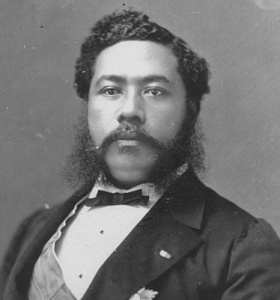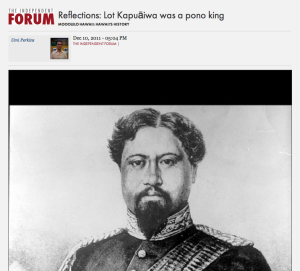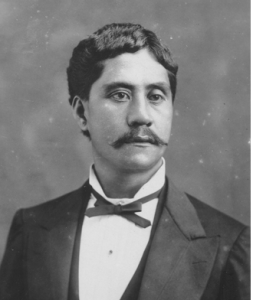10. Hawaiian women in the Kingdom could not vote, so the constitution, and the country, was sexist
While it’s technically true the women couldn’t vote, this needs to be put into context: Lunalilo was thinking of universal suffrage in the early 1870s, but did not live long enough to achieve it (he did achieve universal male suffrage). Had he lived longer, Hawaiʻi may have been the first country to grant women the right to vote, because the official first country to do so was New Zealand in 1893! So, yes, women couldnʻt vote in the 1870s and 1880s – they couldnʻt vote anywhere in the world! In fact, women in the Hawaiʻi legislature (House of Nobles) could vote as early as 1840 – this is calmly reported in the main Hawaiian history textbook as if itʻs not a big deal, but it means that one might be able to argue that Hawaiʻi was, in fact, the first country to allow women (certain women) to vote.
9. Missionaries overthrew Hawaiʻi
Anyone who knows their Hawaiian history well at all knows this isnʻt true – not technically. None of the leaders of the overthrow were themselves missionaries. They were the sons and grandsons of missionaries, and often called the “Mission boys” – the “boys” of the missionaries – and colloquially “missionaries.” But none of them were actually missionaries because that wasnʻt the thing to do in their generation – they all became businessmen in sugar and related industries. The only exception was Hiram Bingham’s son, who became a missionary, but went to the South Pacific, and had no involvement with the overthrow. A related misconception (among those who have only a cursory knowledge of Hawaiian history) is that missionaries helped abolish the kapu system. Since they were climbing aboard a ship in Boston harbor when that happened, it’s impossible for them to have done so.
8. Hawaiians did not resist the overthrow or annexation
OK, this one is pretty well known to be false by now, but itʻs worth remembering that in the 1980s, Haunani-Kay Trask had to defend the idea of Hawaiian resistance, and could only refer to the lyrics of “Kaulana nā Pua” in support of the idea. Now, with the Kūʻē petitions, we see that not only did Hawaiian resist, they resisted nonviolently and violently (with the Wilcox rebellion). In other words, Hawaiians did everything possible to prevent annexation.
7. Kalākaua was powerless after the 1887 Bayonet Constitution.
Historian Ronald Williams Jr. has uncovered strenuous debates between Kalākaua and the legislature in which he pushes hard for returning power to the throne – quite a different King from the one commonly portrayed as a broken man.
6. The 1893 overthrow was “US-backed”
Louis “Buzzy” Agard has found evidence that the US planned the overthrow ahead of time. Agard found an encoded message (and then found the key!) from the State Department telling the USS Boston to attack ports in Hawaiʻi, ending in Honolulu. That makes it a straight-up US overthrow.
5. Kamehameha V was a despot
According to A. Grove Day in History Makers of Hawaii:
[Lot Kapuaiwa] believed that the example of his grandfather, KAMEHAMEHA I, gave him the right to lead the people personally, and favored a stronger form of monarchy that verged on despotism.
This description comes partly from the period, when in 1864 “it appeared that a new constitution could not be agreed on, he declared that the Constitution of 1852 should be replaced by one he wrote himself” (Day, 1984, 70). But the power to do that was in the old constitution, and if one looks at the new Constitution, that power is absent. In other words, Lot had reduced his own power rather than increasing it. Members of the legislature thanked him afterward.
4. Pauahi was the last of the high-born Kamehamehas
The last of the high-born Kamehamehas was Albert Kūnuiakea, son of Kamehameha III. Albert seemed to be a persona non grata since he was “illegitimate” as the son of Kauikeaouli and Jane Lahilahi Young. This made him Queen Emma’s cousin, and the black sheep of that family. He was literally “the man would be be king,” that is, if the missionaries hadnʻt brought the notion of illegitimacy with them.
Think about it: he could have been Kamehameha IV, rather than Alexander Liholiho, and Albert lived into the twentieth century. So the son of Kamehameha III could have been king for 40 years by the time of the overthrow, making such an event much less likely. He is buried at Mauna Ala, recognition that he was a royal in the 20th century.
There are also many other descendants of Kamehameha – see the book Kamehameha’s Children Today.
3. Hawaiians lost their land in the Māhele
My own research, as well as that of Donovan Preza, Robert Stauffer and Keanu Sai, shows that Hawaiians co-created the “Western-modelled” land tenure system along with advisors, and that many Hawaiians learned the system, and had land (this is why Kamehameha V’s property requirement for voting is not as bad as it might look otherwise). Stuffer shows that they lost land mainly due to foreclosure after 1874 due to the non-judicial foreclosure law, which eliminated judicial oversight. Preza (The Empirical Writes Back, 2010) shows that the Māhele was a “necessary but not sufficient” condition for land dispossession. My research (Kuleana: A Genealogy of Native Tenant Rights, 2013) suggests that the land tenure system embedded Hawaiian rights in land rather than alienation Hawaiians from it.
2. A great majority of Hawaiʻi residents supported Statehood in 1959
Ron Williams wrote that Lamar Alexander, in 2006, expressed the commonly held view: “In 1959,94 percent of Hawaiians reaffirmed that commitment to become Americans by voting to become a State” (Williams, 2). He also shows that, while it may be true that the vast majority of Hawaiʻi residents who voted supported Statehood in 1959, only 132,000 people actually voted for Statehood – about one-fifth of the population at the time (20.7% to be precise). This is a far cry from 94%.
(See Williams, ʻOnipaʻa ka ʻOiaʻiʻo: The Truth is Steadfast)
Dean Saranillio also tracked anti-Statehood sentiment in his dissertation (Michigan, 2009) Seeing Conquest, noting that Kamokila Campbell had opposed statehood and in fact become a kind of mouthpiece for those who opposed it, but feared for the loss of their jobs or other repercussions. Campbell, who was part of the Kawananakoa family and became famous for saying “I am Hawaiʻi,” opposed “forfeiting the rights of natives of these islands for a thimbleful of votes” in Congress.
1. Annexation
That it happened. Without a treaty. Legally or illegally. This isnʻt as widespread these days as the others, but whatʻs at stake is obviously much, much greater than with the others. Those who say there was an “illegal annexation” neglect the fact that annexation is precisely the legal aspect of a conquest, thus it’s an oxymoron. Those who point to Supreme Court decisions neglect the fact (as I said in my debate with Ian Lind) that there were two countries involved, and one country’s court, no matter how supreme, simply does not have a say in the legality of their action – it is an international issue. Those who say international law does not exist fail to consider what other countries think when its understandings are violated (as with Iraq in 2003): could we be next? Whatʻs to stop the US or China from taking us over if there are no rules? That’s why these international norms are in place. China, in fact, seems to be on to the US occupation – in 2011, they said “we could claim Hawaiʻi,” to which then-Secretary of State Hilary Clinton responded “weʻll prove we own it,” showing that she understood it was a challenge to the US occupation, not a threat to simply invade.
While some misconceptions have more impact than others, the cumulative effect of these, and many other myths (when combined with a plain and complete ignorance of Hawaiian history on the part of many) is to distort courses of action and decision-making processes. This is true even, and perhaps especially, among Hawaiians themselves.






This is nice work you are doing. Have you leafed through pages and pages of land turned over to Hawaiians as a result of The Great Mahele? A relative of mine (part-Hawaiian) was the judge who helped KIII with this offering. Few cite it, or explain what happened to it–the land. Always fascinated me, the idea of land being “stolen” when its taken away for not paying taxes. Auwe! Away. Am interested in your perspectives on any subject. Thank you for what you do.
LikeLiked by 1 person
Mahalo for reading the blog. I think one of my students from KS interviewed you when your book came out..
LikeLike
Umi, I’m working on a paper (with citations) that asserts that the President Harrison, the Secretary of the Navy, and Foreign Minister Stevens conspired to militarily take over Hawaii. I’d like to send to you the first draft, but only if you’re interested. johnhughmcfadden@hotmail.com
LikeLiked by 1 person
Bernice Pauahi was actually not truly a Kamehameha. Her grandfather, Pauli Kaʻōleiokū was a son of High Chief Kalaniʻōpuʻu. The myth that Pauli was a son of Kamehameha I began after Kamehameha’s death. He was raised as a son of Kalaniʻōpuʻu and lived his entire life as a son of Kalaniʻōpuʻu. He was saved by Kamehameha I and accepted into the Royal Court but was always considered a cousin by his uncle. When given the chance to take the throne by Kamehameha V, Bernice was horrified at the thought and refused. While she is known for founding the Kamehameha Schools, she herself was a cousin. These facts are confirmed through the Hawaiian Historical Society from an extensive paper from 1931 as well as many other scholars and historians.
LikeLike
So those sources disprove John Papa Iʻi? He says Kalaniopuʻu was “irritated” by Kamehamehaʻs fathering a child with his wife. Iʻve also heard (but not confirmed) that Pauahi turned down the throne because it would give undue influence to Charles Reed Bishop, an American (probably due to coverture laws).
LikeLike
The issue is not as cut and dry. We don’t know what Kamehameha and Pauli Kaoleioku actually said or did in their lifetime. It is all incomplete hearsay. Historians and genealogists disagree on the topic and other believed he was a poolulu child of Kamehameha and Kalaniopuu. John Stokes wrote an article in the Hawaiian Historical Society a few decades ago about this topic.
It is significant though how many people during the monarchy believed, treated and respected Pauahi and Keelikolani as descendants of Kamehameha I. I mean many people still call both of them “princess” even though they were never referred to as such until after their death. Other cousins of Kamehameha I and descendants of Kalaniopuu did not have any position of rank or power to their equivalence.
LikeLike
Could you share more with regards to your statements in #6? How was haunani-kay tasked with defending “the idea of Hawaiian resistance”, to which she could “only” answer with references to the anthem to our lāhuis resistance?
LikeLike
This is in her book and reiterated in Noenoe Silva’s book Aloha Betrayed
LikeLike
Pingback: Quick Links: Islands | 上り口説 Nubui Kuduchi
After the Great Mahele was formed, the haoles took advantage of the fact that Hawaiians didn’t fully understand the concept of ownership. When they signed over the rights of land that they “owned”, their understanding was that they were leasing out the rights to use the property until he/she passed away voiding the contract, returning the rights back to his/her family. Also, besides women being able to vote, you as an individual were required to own property to vote. Many Hawaiians who didn’t understand what was happening signed over the rights not only for the land they owned but also their right to vote. Knowing all of this, the “Mission Boys” and their associates were able to tread carefree and the development of Hawaii ensued.
LikeLike
Reblogged this on this is Malia.
LikeLike